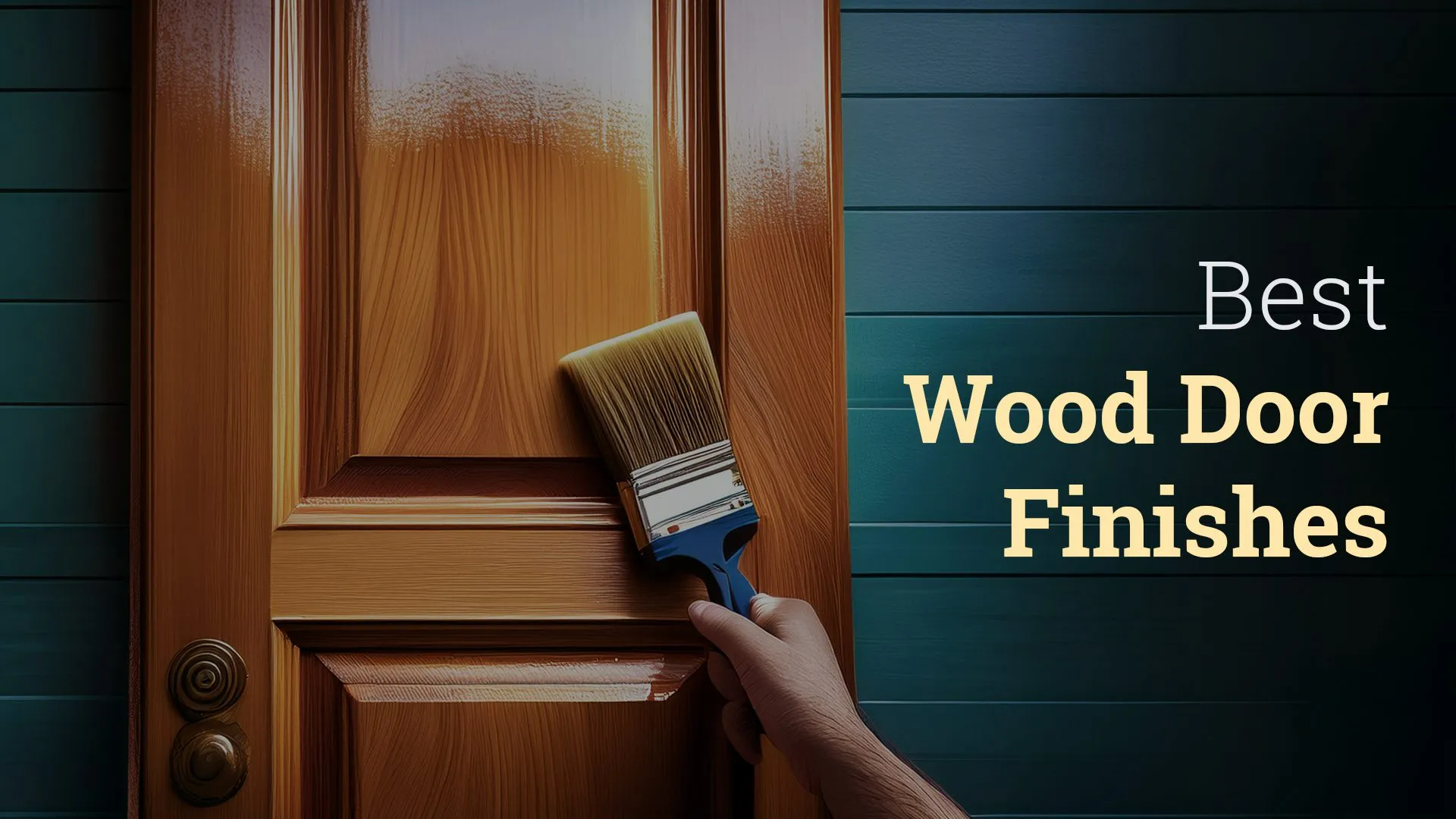Every door of the building tells a story, especially the wood. Commercial spaces like offices, hotels, and retail use wood door widely. A good-quality door lasts longer, but it needs protection. It can get scratched, damaged by moisture, and worn down from daily use. To back up your door investment, you need a protective layer that makes your door last even longer.
Oil vs. Water-Based Wood Door Finishes
Wood door finishes are of two categories: water-based and oil-based finishes. Oil-based and water-based. The difference is in the solvent that carries the solids. Water-based uses water. Oil-based uses petroleum solvents. This changes how they look, how they last, and how you apply them.
Oil-Based Wood Door Coatings
Hollow metal doors are the most common choice for commercial buildings. It has a strong metal exterior and a hollow core. The core has a honeycomb design made with insulating materials like polystyrene or polyurethane. Hollow metal door frames key features are:
- Aesthetic: Creates a warm, yellowish tone that elevates woods natural color over time.
- Durability: Shield door from daily wear and surface damage.
- Application Time: Takes more times to dry. Recommended overnight drying between applications.
- Fumes/Emissions: It has strong chemical odors and volatile organic compound levels.
- Maintenance: To clean solvent-based cleaners like turpentine is used.
Water-Based Wood Door Coatings
- Aesthetic: Fast-drying formula keep’s wood original color intact.
- Durability: Modern versions offer comparable scratch protection to traditional oil formulas.
- Application Time: Quick drying property makes easier to apply multiple coats in shorter duration.
- Fumes/Emissions: nearly odorless, emits lowed chemical hence has reduced environmental impact.
- Maintenance: It is easy to clean using soap and water.
Types of Wood Door Finishes
Applying wood door finishes is a smart investment. It is like shielding your door from damage. Additionally, it preserves your wood’s natural beauty. Unfinished wood doors are likely to swell with water. This can lead to significant problems, especially for fire-rated doors. The following are some of the common types of door finishes used in high-traffic areas:
Polyurethane Finish
Polyurethane is a strong, plastic-like finish used for coating several materials, including wood. It’s a clear synthetic material. You can find it in two types: oil-based and water-based finishes.
Oil-based polyurethane has a natural yellowish finish. Over time, the color deepens, giving the doors a rich glow. It is more durable and resistant to abrasion. Water-based polyurethane, on the other hand, dries quickly. It is ideal for lighter colored woods or when you want to preserve the natural color of the material.
- Pros: Highly durable, water-resistant. Deep wooden finish (oil-based), durable. Dries quickly (water-based polyurethane).
- Cons: It does not protect the door from sun exposure. Avoid using it outdoors. It needs recoating after some years, and the polyurethane material can tear out.
Lacquer Finish
Lacquer is a solvent-based wood finish. It gets sprayed easily, providing a glossy finish to wood. It is ideal for preserving and maintaining indoor door and furniture.
- Pros: Dries swiftly, allowing application of multiple coats in a short time. A first coat fits very well on top of another. This makes repairing worn and torn items easy with quick touch-ups
- Cons: Only moderate durability, so it’s best for frames with lighter use. Traditional nitrocellulose lacquer can yellow with age. The fumes are toxic and flammable. So, use safety gear and ensure good ventilation when applying.
Varnish Finish
A Varnish finish is a transparent and durable wood door coating. It gives a wood door a hard and clean finish, elevating the wood’s natural color and texture. This makes it ideal for protecting the natural beauty of timber.
- Pros: Keeps wood’s natural beauty intact for the long run. Provides a sheen and glossy view to the door. Oil-based varnish makes the door water-resistant. Water-based varnish dries quickly and won’t turn yellow.
- Cons: Takes time to dry and requires 4 to 6 coats for sealing the door. Produces strong fumes, so wear a mask and ventilate. Though durable, it wears down outdoors and needs recoating to maintain protection.
Paint Finish
Paint gives an opaque color layer, hiding the wood grain completely. It is popular for achieving specific looks and covering flaws in lower-grade wood. With the right type, it offers a protective and long-lasting surface.
- Pros: Array of color options available. It can be customized to match the home’s color theme. Hides imperfections and minor damages. Forms a protective layer that resists dirt and wear; exterior paints guard against UV damage.
- Cons: it seals the natural grain of quality wood. Durability and performance depend upon the use. In case of heavy use, it is likely to peel off. Requires touch-up in regular intervals to avoid chipping.
Bottom Line: Right Finish for Long-Lasting Wood Doors
Finishing your wooden door with an oil-based or water-based finish is an essential step. Choose the finish that best meets your requirements. Without this protective layer, your door is more prone to cracking and warping. This can cause you pricey repairs and even costly replacement at times. To preserve the natural beauty of wood doors, applying a wood door finish is essential. This is especially useful for exterior doors. Preserve your door’s structural integrity by choosing the right door finish.
Looking for pre-finished wood doors and wood door frames for your next project? We are here to help. Reach out to us, Aorbis, for high-quality wooden exterior and interior doors. From fire-rated doors to pre-finished and varnished doors, we get you the ideal door options.
FAQs
1. What is the best finish for interior doors?
Polyurethane semi-gloss or satin finishes is a good option for interior doors. This water based solvent is easier to clean and shield the door from scratches.
2. Why is polyurethane a good finish for wood?
Polyurethane forms a hard layer on wood for additional protection. Its oil-based finish types give wood a warm amber effect. While the water-based finish is a very clean layer.
3. What is the best way to seal a painted wooden door?
The best way to seal a painted door is to apply wood finish later. Use water-based polyurethane or polycrylic finish after paint. Ideally, two or a thin coat of the polyurethane finish works. For lighter painted wood, choose a non-yellowing finish.
4. Does polyurethane make wood waterproof?
Polyurethane is a water resistant wood door finish and not waterproof. If your door is more prone to moisture, use varnish finishes. Make use of marine varnish, epoxy, or exterior spar urethane.
5. Can polyurethane fill wood grain?
No, it does not. To fill the wood grain, you need to use a grain filler or sanding sealer. Use the filler before finishing for a smooth surface.
6. How many coats of polyurethane should I apply?
The number of coats to apply will depend on the wood’s dimensions and quality. For interior timber, three thin coats are best. For exterior wood doors, aim for four to five coats. Sanding between coats with 220-grit works well.
7. Can I apply polyurethane over varnish?
Yes, depending upon the door use, you can apply polyurethane after varnish. To do so, make sure the varnish is clean and sanded to dull the surface. Discard any loose varnish and have a small spot test before.
8. Which paint is best for outdoor wood?
High-quality exterior acrylic latex works for most surfaces. Use oil-based enamel for heavy wear or chemical resistance.
9. Is painting or polishing better for wooden doors?
Paint covers flaws, offers color choice, and needs less upkeep. Polishing shows the grain and feels natural. Choose based on your preference.




